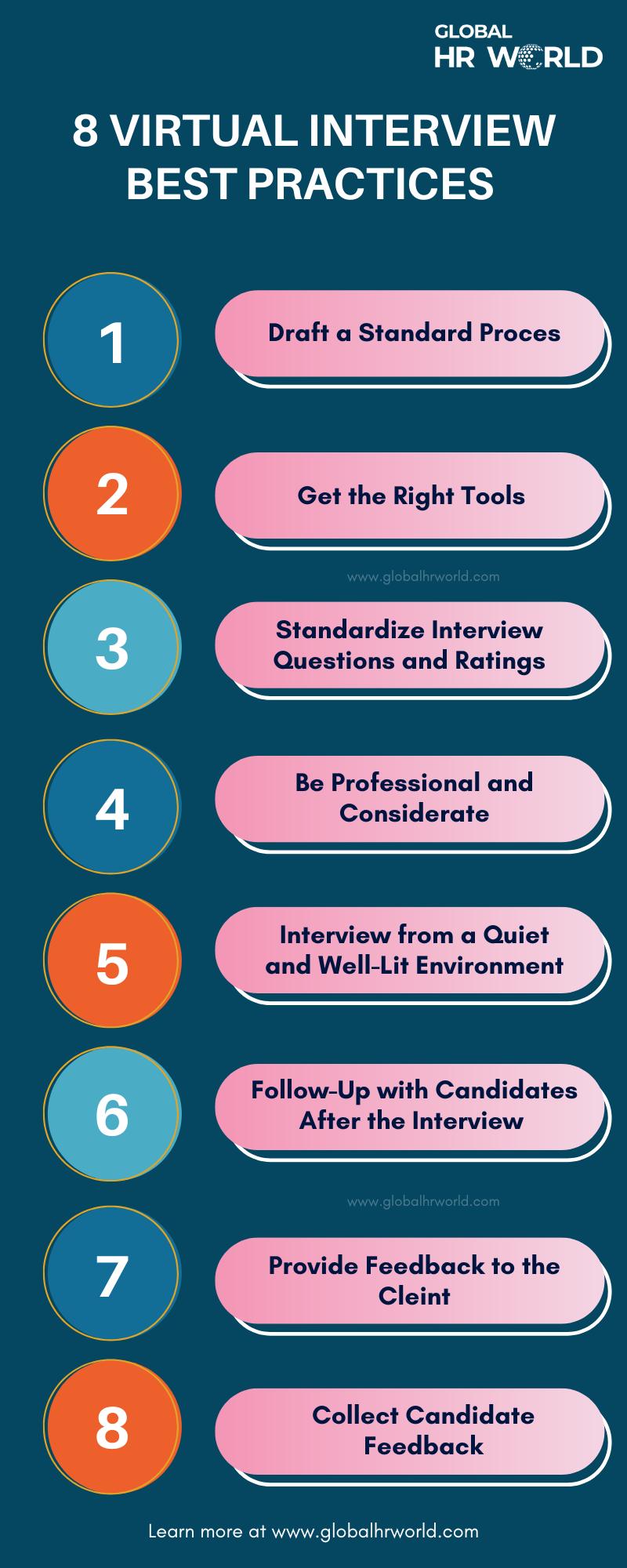In an increasingly digital world, remote work and remote hiring have become a mainstay. Organizations now conduct a significant chunk of their hiring process virtually, even when hiring for in-person roles, due to its convenience and broader reach. To ensure that your virtual interviewing process is smooth and efficient, setting virtual interview best practices in your organization is crucial.
This will not only lead to standardization in your virtual interviewing process but also leave a better impression on potential recruits by giving them a pleasant interviewing experience, increasing their chances of picking your organization as one of their top choices. This article will give you 8 virtual interview best practices for interviewers so you can begin the hiring process with each candidate on the right foot.
Here are 8 Virtual Interview Best Practices for Interviewers
Virtual Interview Best Practice #1: Draft a Standard Process for Conducting Virtual Interviews
The first virtual interview best practice is to draft a standard process for conducting virtual interviews. While all interviews are a little different from each other, it helps for organizations to have a consistent overall procedure and sequence for conducting them so that all the people involved in the hiring process know each step they are required to follow.
This also makes it easier to communicate with candidates, especially if you’re working in a larger organization, because everybody involved in the interview process is aware of the organization’s protocol.
Virtual Interview Best Practice #2: Get the Right Tools for Conducting Virtual Interviews
Video conferencing tools are essential for conducting virtual interviews. Hence, organizations should ensure that they invest in the right ones. It is recommended to pick more accessible options for interviewing candidates to make the process easier for them. This might mean using a video conferencing tool that isn’t typically used for internal meetings. Ideally, one that doesn’t require interviewees to download a new application onto their system should be picked.
You will also need to ensure that the tool you pick has adequate features so your virtual interview goes without a hitch.
Lastly, before each meeting, make sure to test the tool and the meeting link to ensure you’re in the right place and there are no issues to troubleshoot.
Virtual Interview Best Practice #3: Standardize Interview Questions and Ratings
In the same vein as developing a standard process for conducting interviews, it is also recommended to develop standardized interview questions and ratings.
For each role you are hiring for, come up with an interview guide beforehand and share it with all the personnel that will be involved in the interviewing process. Additionally, for questions where interviewers will need to rate interviewees on certain parameters, develop a standardized rating system with clear descriptions for each rating level so the ratings remain somewhat consistent even if there are multiple interviewers.
Virtual Interview Best Practice #4: Be Professional and Considerate
It is crucial to be professional even when dealing with virtual candidates. Consistently communicate with candidates with clear updates about the interview. Maintain a friendly and professional tone throughout all communications. Give candidates adequate information and be prompt about getting back to them when they reach out. Additionally, inform of any reschedules in advance. Similarly, schedule interviews in advance and always set a date after discussing and confirming it with your candidate.
This will lead to a pleasant interview experience, improving your organization’s impression as an employer in potential recruits’ eyes.
Virtual Interview Best Practice #5: Conduct the Interview in a Quiet and Well-Lit Environment
If you’re interviewing from within the office, pick a quiet meeting room to attend the virtual meeting. Let others know that you are occupied during the interview’s time slot to avoid interruptions. Lastly, keep your gadgets and system notifications on silent.
When interviewing from your home office space, the same rules will apply. Also ensure that the location you take the interview from within your home is well-lit and clean.
Virtual Interview Best Practice #6: Follow-Up with Interview Candidates After the Interview
After the interview has been conducted, be sure to follow up and thank the candidate. Additionally, give them all the necessary details about the next steps, such as when they might expect to hear back about their results for the round, what the next stages of the hiring process will entail, etc.
Virtual Interview Best Practice #7: Provide Feedback to the Candidate
For each round, or at the end of the interview process, provide candidates with feedback about their performance, regardless of the result.
In case the candidate was not selected, give them a personalized reason instead of a standard notification of not being selected. Be sure to include both, strengths and weaknesses to avoid discouraging the candidate. This will give job-seekers more information to work with for future opportunities, as well as your current correspondence on a positive note.
Virtual Interview Best Practice #8: Collect Candidate Feedback
Apart from providing feedback, it is also recommended to collect feedback from candidates about the interview process. This information can be used to improve the process for future candidates.
Infographic




